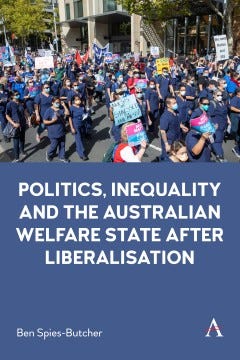Politics Reconstructed
An exclusive extract from a brilliant new book about economic reform in Australia
Dear readers,
I want to bring to your attention to a new book by Australian academic, Ben Spies-Butcher.
Politics, Inequality and the Australian Welfare State After Liberalisation is an essential read for anyone wanting to understand how the governance of our island-nation has changed over the last forty years. It is also an insight into the future of progressive reform. Spies-Butcher provides a deep dive into the changes and continuities of the relationship between economics and politics that have seen a unique, Australian version of neoliberalism emerge since the early 1980s. With Ben’s permission, I am publishing this extract, and it is a section that nicely captures the analysis he provides. But by all means, grab a copy of the book and read the whole thing.1
Extract from Politics, Inequality and the Australian Welfare State After Liberalisation by Ben Spies-Butcher
The welfare state is not what it was. Decades of liberalisation have transformed how governments provide social policy and how citizens experience social protection. Services that were once the sole domain of public sector workers are now run by non-profit, even for-profit, firms. Payments that were once straightforward to access and understand are increasingly conditional and stingy, or require expert advice to invest in complex financial products. Even within the public sector, new public management and competition policy have created markets within the state, transforming the public sector into something that looks much more like the private sector.
Yet for all this transformation, predictions of a crisis of the welfare state have proven premature. Across the OECD, and particularly in Australia, the welfare state is on the march. The growth is both quantitative and qualitative. Through the height of neoliberalism social spending grew, and even before Covid-19, had moved closer to the OECD average (OECD 2022c). Areas of social need, such as child, disability and elder care, are supported in ways they were not before. And even though inequality overall has increased, social spending has also become more redistributive, doing more to ease inequalities than in the past (Whiteford 2017).
Much of this change is structural. As populations age there is more need for pensions and healthcare, two of the biggest components of the welfare state. As family structures change and women enter paid work in greater numbers, demands for paid care expand and parenting payments increase. Welfare states redistribute more when our initial market incomes are less equal, as happens when labour and capital markets are deregulated. However, deliberate policy also played a role. New programs have been introduced, and existing spending increased under both Labor and Coalition governments.
This book attempts to understand the varied politics of liberalisation in Australia and understand how to change it. Of course, we can exaggerate difference. Australia never developed a comprehensive welfare state equivalent to those in Europe, or even the UK. We have always had sizeable private sectors in health, education and care and relatively low social benefits. Social policy and the politics of welfare have changed since the 1980s, however less dramatically than many imagine. Liberalisation has not meant the end of the state, but the expansion of markets alongside welfare.
The analysis in this book follows an earlier political economy tradition that understands the welfare state as a form of social compromise between capitalism and democracy (O’Connor 2017; Offe 2018; Streeck 2014; Esping-Andersen 2015). From this perspective, liberalisation is generally understood as a winding back of that compromise. Liberalisation was driven by a political project, neoliberalism, to limit democratic state action. It imposed hard limits, or fiscal constraints, on the economic size of the state (see Streeck 2014, 72–77), and delegated economic decisions from democratic politics to technical experts (Mattei 2022). I suggest this is an important, but partial, understanding. Alongside the imposition of fiscal constraints on welfare expansion, people have continued to resist the insecurities and inequalities produced by market economies, and this social resistance continues to shape policy outcomes.
While pressures of fiscal constraint and social resistance are common across the OECD, Australia’s response is somewhat distinct. Our welfare state has more thoroughly embraced the logic of competition. Unlike much of Europe ‘social’ questions are invariably referred to the ‘Productivity’ Commission. And unlike the more overt politics of the New Right in the United States and the United Kingdom this has not been simply ‘anti-state’, rather Australia is, to use Michael Pusey’s famous phrase, ‘economically rationalist’ (1991). Liberalisation has been far more technocratic than overtly political.
Technocracy, of course, is often a tactic of those opposed to the democratisation of the economy (Mattei 2022). Australia’s technocratic politics has driven unpopular privatisation and marketisation (McKenna 2000). But as austerity has confronted political pressure, it has also proved fertile ground for novel policy innovations. Caught between economic pressures to constrain state finances and democratic pressures to insulate people from inequality and insecurity Australia has favoured technical solutions.
Technocratic policy entails new forms of statecraft that shift how and where social policy is contested. Rather than only viewing neoliberalism advancing against a previous order, this book understands liberalisation as a process that reworks the terrain on which politics is contested, producing new patterns of insecurity, inequality and social protection.
Rarely is the state wound back. It is instead rolled out (Peck and Tickell 2002) and reorganised to imitate and enforce market structures. ‘Choice’ and ‘self-reliance’ advance through the expansion of hidden (Howard 1999, Morel et al. 2019) or dual (Stebbing and Spies-Butcher 2010) welfare. Fiscal support expands to assist largely middle-class households manage social risk through private providers. However, constructed primarily through concessional tax arrangements and regulatory impositions, the ‘public’ nature of finance is obscured and democratic scrutiny that might contest the distribution of benefits avoided.
Liberalisation has also seen hybrid policies that appear to extend social protection while mimicking elements of market competition (Spies-Butcher and Bryant 2023). Hybrid policies respond to democratic pressures, but avoid fiscal constraints by constructing public action in forms that mimic private markets, challenging and reorganising the boundaries of public and private finance in the process. Hybridity has the potential to make hidden welfare visible and dual welfare universal.
Australia’s focus on technocratic governance and its role in pioneering many elements of Third Way governance have seen it develop a reputation for innovative and ‘evidence-based’, ‘hybrid’ policies (see esp. Fabian and Breunig 2018). Indeed, many of the policies examined here have been examined as exemplars of combining states and markets. I build on this literature. However, my analysis is also distinct in two respects. First, while most of the hybrid policy examples I examine are technically efficient, my focus is on the political circumstances and strategies that saw these models advance, while in similar policy domains much less egalitarian forms of dual welfare flourished.
Second, and relatedly, I understand hybridity as a solution to a political, as much as an economic, problem. Hybridity is born from the relationship between public accounting, social need and fiscal constraint that creates pressures for novel policy models. The blurring of boundaries between public and private finance are not simply technical solutions, rather hybridity creates political opportunities to reduce the inertia of austerity, which constrains social spending.
The most egalitarian features of recent social policy were won as political demands, even if their form reflects new modes of liberalised statecraft. The least egalitarian policies have not involved a withdrawal of the state either, but a remaking of state power in less visible and less egalitarian forms, allowing more visible public spending to be stigmatised.
The core of the book is a set of case studies selected to reflect what I see as the most important processes of liberalisation and to highlight differences in how these processes proceed in practice. By analysing how payments are targeted, services marketised and welfare financialised, it aims to understand opportunities to reshape outcomes.
The case studies aim to explain how sometimes means-testing creates poverty and stigma, as with JobSeeker, while at other times payments genuinely reduce poverty and create security, as with the aged pension; or why the marketisation of early education and care saw the rise and fall of ABC Learning, while a similarly marketised health insurance system, Medicare, is held up as an exemplar of public provision.
Across the examples explored in this book several common patterns emerge. Social protection only expands where organised social pressure makes social needs visible, forcing governments to protect citizens from these risks. Egalitarian policies overcame resistance from an increasingly pro-competition state through hybridity. Hybridity promotes competition alongside social protection, and appears to limit increases in state finance while simultaneously expanding the capacity of the state to protect citizens from risk. And egalitarian policies prove durable when they foster large constituencies and frame provision around universal needs.
The importance of organised political pressure appeals to universal values and building broad constituencies all echo earlier welfare state success (Esping-Andersen 1990; Baldwin 1990; Jacques and Noel 2018). However, the locus and dynamics of those movements have changed. Where social policy victories in the post–War Keynesian welfare state were largely the result of industrial struggle by (mostly male) workers, increasingly egalitarian success is the result of alliances built by the (primarily women) workers and citizens most directly engaged in care and welfare provision. Where welfare states were built using Keynesian tools that managed demand by separating public and private finance, liberalisation has increasingly given rise to hybrid models that subvert the discipline of austerity by socialising risk beyond the boundaries implied by measures of public finance.
By understanding these dynamics I hope to not only explain Australian patterns of liberalisation but also inform strategies to change them.
I am reading through the book for a second time at the moment and will try and write a full review at some point and highlight some of the matters I took issue with or would argue the toss over. A detailed, critical account in other words, of what I think is an important book. If anyone else has read it, I’d be keen to hear your opinions. Also note that I am a Fellow at the Australian Basic Income Lab of which Ben Spies-Butcher is a Co-Director.





